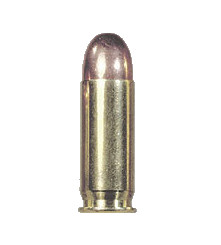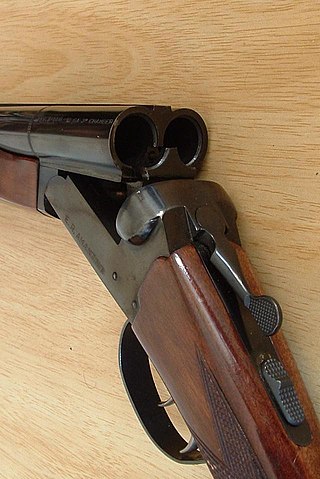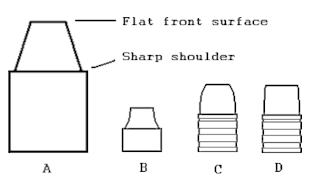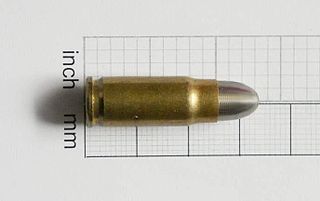
A cartridge or a round is a type of pre-assembled firearm ammunition packaging a projectile, a propellant substance and an ignition device (primer) within a metallic, paper, or plastic case that is precisely made to fit within the barrel chamber of a breechloading gun, for the practical purpose of convenient transportation and handling during shooting. Although in popular usage the term "bullet" is often informally used to refer to a complete cartridge, the correct usage only refers to the projectile.

Rimfire ammunition is a type of firearm metallic cartridge whose primer is located within a hollow circumferential rim protruding from the base of its casing. When fired, the gun's firing pin will strike and crush the rim against the edge of the barrel breech, sparking the primer compound within the rim, and in turn ignite the propellant within the case. Invented in 1845, by Louis-Nicolas Flobert, the first rimfire metallic cartridge was the .22 BB Cap cartridge, which consisted of a percussion cap with a bullet attached to the top. While many other different cartridge priming methods have been tried since the mid-19th century onwards, only rimfire and the later centerfire cartridges survive to the present day with regular usages. The .22 Long Rifle rimfire cartridge, introduced in 1887, is by far the most common ammunition in the world today in terms of units sold.

The .25 ACP (6.35×16mmSR) is a semi-rimmed, straight-walled centerfire pistol cartridge introduced by John Browning in 1905 alongside the Fabrique Nationale M1905 pistol.

The .38 Super, also known as .38 Super +P, .38 Super Auto, .38 Super Automatic, .38 Super Automatic +P, or 9×23mmSR, is a pistol cartridge that fires a 0.356-inch-diameter (9.04 mm) bullet. It was introduced in the late 1920s as a higher pressure loading of the .38 ACP, also known as .38 Auto. The older .38 ACP cartridge propels a 130-grain (8.4 g) bullet at 1,050 ft/s (320.0 m/s), whereas the .38 Super pushes the same bullet at 1,280 ft/s (390.1 m/s). The .38 Super has gained distinction as the caliber of choice for many top practical shooting competitors; it remains one of the dominant calibers in IPSC competition.

In firearms, headspace is the distance measured from a closed chamber's breech face to the chamber feature that limits the insertion depth of a cartridge placed in it. Used as a verb by firearms designers, headspacing refers to the act of stopping deeper cartridge insertion. The exact part of the cartridge that seats against the limiting chamber feature differs among cartridge and gun designs. In general, bottleneck rifle cartridges headspace on their case shoulders; rimmed cartridges headspace on the forward surfaces of their case rims; and rimless pistol cartridges headspace on their case mouths. The case belts on belted cartridges were originally added to allow headspacing on the belt's forward surface, but in practice this is often vestigial and rifles chambered in belted cartridges may well headspace them on their shoulders.

The 9×23mm Largo centerfire pistol cartridge was developed in 1901 for the Bergmann Mars pistol.
A rim is an external flange that is machined, cast, molded, stamped, or pressed around the bottom of a firearms cartridge. Thus, rimmed cartridges are sometimes called "flanged" cartridges. Almost all cartridges feature an extractor or headspacing rim, in spite of the fact that some cartridges are known as "rimless cartridges". The rim may serve a number of purposes, including providing a lip for the extractor to engage, and sometimes serving to headspace the cartridge.

In breechloading firearms, an extractor is an action component that serves to remove spent casings of previously fired cartridges from the chamber, in order to vacate the chamber for loading a fresh round of ammunition.

A semiwadcutter (SWC) or flat-nose is a type of all-purpose bullet commonly used in revolvers. The SWC combines features of the traditional round-nosed bullets and the wadcutter bullets used in target shooting, and is used in both revolver and rifle cartridges for hunting, target shooting and plinking. Full wadcutters frequently have problems feeding from magazines reliably in semi-automatics, so SWCs may be used when a true WC is desired but cannot be used for this reason.

Henri-Gustave Delvigne was a French soldier and inventor. He became a captain in the French infantry service, from which he resigned on the outbreak of the 1830 July Revolution. Delvigne revolutionized rifle technology and rendered it proper as a weapon.

The 1931 Fabrique Nationale (FN) Baby Browning is a small blowback-operated semi-automatic pistol designed by Belgium-born Dieudonné Saive chambered in .25 ACP. The pistol features a six-round magazine capacity and is a striker-fired, single action, blow back mechanism. The manual thumb operated safety locks the slide in the closed position when engaged using side thumb pressure.

The 9×25mm Mauser is a cartridge developed for the Mauser C96 service pistol around 1904 by DWM. Mauser pistols in this relatively powerful caliber were primarily intended for export to Africa, Asia, and South America. The 9mm Mauser Export cartridge was produced specifically for Mauser pistols and carbines made from 1904 to 1914 and then later from approximately 1930 to 1945 for submachine guns chambered for this caliber.

The Bergmann 1896 was a 19th-century semi-automatic pistol developed by German designer Louis Schmeisser and sold by Theodor Bergmann's company. A contemporary of the Mauser C96 and Borchardt C-93 pistols, the Bergmann failed to achieve the same widespread success, although Bergmann himself later went on to design one of the earliest practical and successful sub-machine guns, the MP-18.
The .45 Mars Long is an experimental centerfire pistol cartridge developed in the late 19th century. The similar .45 Mars Short used the same cupro-nickel-jacketed bullet in a case shortened to 0.66 inch. The bullet has two deep cannelures, and the case is crimped into both. The case mouth is chamfered on the outside to fit flush into the forward cannelure. The cartridge headspaces on this conical forward crimp. This elaborate bullet seating was necessary to withstand the violent feed mechanism of the Mars Automatic Pistol. The case has a thin rim and deep extractor groove in comparison to most rimless pistol cartridges. The Mars cartridges were publicized as the most powerful handgun cartridges through the early 20th century, but fewer than 100 pistols were made and manufacture ceased in 1907. Ballistically the cartridge falls between the .45 Super and .45 Winchester Magnum.
The 9 mm Mars is an experimental centerfire pistol cartridge developed in the late 19th century based on necking down the .45 Mars Long case. The bullet has two deep cannelures, and the case is crimped into both. The case mouth is chamfered on the outside to fit flush into the forward cannelure. This elaborate bullet seating was necessary to withstand the violent feed mechanism of the Mars Automatic Pistol. The cartridge headspaces on the shoulder adjacent to the neck. The case has a thin rim and deep extractor groove in comparison to most rimless pistol cartridges. There was a very similar 8.5mm Mars cartridge firing a 139 grain bullet at 1550 feet per second. The Mars cartridges were publicized as the most powerful handgun cartridges through the early 20th century; but less than 100 pistols were made and manufacture ceased in 1907.
The 8.5mm Mars is an experimental centerfire pistol cartridge developed in the late 19th century based on necking down the .45 Mars Long case. The bullet has two deep cannelures, and the case is crimped into both. The case mouth is chamfered on the outside to fit flush into the forward cannelure. This elaborate bullet seating was necessary to withstand the violent feed mechanism of the Mars Automatic Pistol. The cartridge headspaces on the shoulder adjacent to the neck. The case has a thin rim and deep extractor groove in comparison to most rimless pistol cartridges. There was a very similar 9mm Mars cartridge firing a 156 gr bullet at 1,400 ft/s (430 m/s). The Mars cartridges were publicized as the most powerful handgun cartridges through the early 20th century; but fewer than 100 pistols were made and manufacture ceased in 1907.
The 5mm Bergmann is an unusual centerfire cartridge produced for very early self-loading pocket pistols. The case is steeply conical and headspaces on the conical case walls. Early versions were made without any rim or extraction groove; and relied upon blow-back for expulsion of the fired case from the chamber. Later Bergmann pistols provided an extractor requiring a groove which produced a semi-rimmed case. The long bullet was inadequately stabilized and tended to tumble in flight.
The 5mm Clement is a centerfire cartridge produced for early self-loading pocket pistols made by Charola-Anitua and a 1903 design by Clement. The steeply conical, bottle-necked case is semi-rimmed, but headspaces on the shoulder of the case. The long bullet was inadequately stabilized and tended to tumble in flight. The Charola-Anitua pistol was produced in very limited numbers, and Clement pistol production shifted to the .25 ACP cartridge after 1906.

The 7.63×25mm Mauser round was the original cartridge for the Mauser C96 service pistol. This cartridge headspaces on the shoulder of the case. It later served as the basis for the 7.62mm Tokarev cartridge commonly used in Soviet and Eastern Bloc weapons.

The 7.65×21mm Parabellum is a pistol cartridge that was introduced in 1898 by German arms manufacturer Deutsche Waffen- und Munitionsfabriken (DWM) for their new Pistol Parabellum. The primary developers of the pistol cartridge were firearms designers Georg Luger and Hugo Borchardt, who developed the round from the earlier 7.65×25mm Borchardt while working at DWM.














